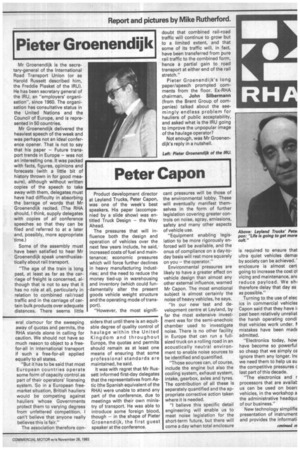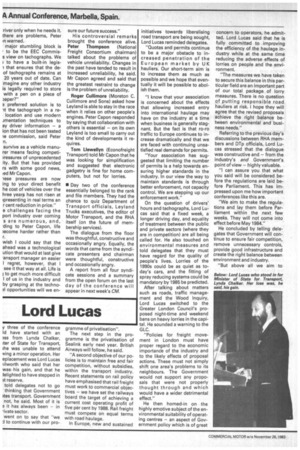Peter Capon
Page 27

Page 28

If you've noticed an error in this article please click here to report it so we can fix it.
Product development director at Leyland Trucks, Peter Capon, was one of the week's best speakers. His paper (accompanied by a slide show) was entitled Truck Design — the Way Ahead.
The pressures that will influence both the design and operation of vehicles over the next few years include, he said,' increased costs of fuel and maintenance; economic pressures which will force further declines in heavy manufacturing industries; and the need to reduce the money tied-up in warehousing and inventory (which could fun • damentally alter the present goods vehicle weight structure and the operating mode of transport).
"However, the most signifi cant pressures will be those of the environmental lobby. These will eventually manifest them selves in the form of further legislation covering greater controls on noise, spray, emissions, safety and many other aspects of vehicle use.
"Equipment enabling legislation to be more rigorously enforced will be available, and the onus of compliance on a day-to day basis will rest more squarely on you — the operator."
Environmental pressures are likely to have a greater effect on vehicle design than almost any other external influence, warned Mr Capon. The most emotional subject is almost certainly the noise of heavy vehicles, he says.
"In our new test and development centre at Leyland, by far the most extensive invest ment was for the semi-anechoic chamber used to investigate noise. There is no other facility in Europe that can run a fullsized truck on a rolling road in an acoustically neutral environment to enable noise sources to be identified and quantified.
"Those sources can, of course, include the engine but also the cooling system, exhaust system, intake, gearbox, axles and tyres. The contribution of all these is separately quantified and the appropriate corrective action taken where it is needed.
"I believe this specific detail engineering will enable us to meet noise legislation for the short-term future, but there will come a day when total enclosure is required to ensure that ultra quiet vehicles dernar by society can be achieved. enclosure is almost cert. going to increase the cost 'DI vicing and maintenance, anc reduce payload. We shi therefore delay that day as as possible."
Turning to the use of elec ics in commercial vehicles Capon said that they have ii past been relatively unreliat the harsh operating condi that vehicles work under. mistakes have been madE admitted.
"Electronics today, how have become so powerful so cheap that we simply ca ignore them any longer. Inc we need them to help us su the competitive pressures c last part of this decade.
"The electronics and r processors that are availat us can be used on boarc vehicles, in the workshop a the administrative headquE. of our business."
New technology simplifie presentation of instrument and provides the informati river only when he needs it. there are problems, Peter in warned,
major stumbling block is to be the EEC Commiss view on tachographs. We to have a built-in legis1 that ensures that the deof tachographs remains at 20 years out of date. Can magine any other industry is legally required to store with a pen on a piece of Japer?"
3 preferred solution is to it the tachograph in a relocation and use modern amentation techniques to ay driver information — a ion that has not been tested le commission, said Peter n.
survive as a vehicle menurer means facing competimessures of unprecedented ity. But that has provided rs with some good news, led Mr Capon.
iese pressures are now ing to your direct benefit he cost of vehicles over the hree years has not risen at :presenting in real terms an r cent reduction in price." e challenges facing the port industry over coming s are numerous, and, 'ding to Peter Capon, life )ecome harder rather than r.
wish I could say that the ahead was a technological ution that would at last give 'ansport manager an easier I regret, however, that I see it that way at all. Life is j to get much more difficult I of us in the industry and by grasping at the techno3I opportunities will we en sure our future success."
His controversial remarks brought the conference alive. Peter Thompson (National Freight Consortium chairman) talked about the problems of vehicle unreliability. Changes in the past have tended to result in increased unreliability, he said. Mr Capon agreed and said that the greatest restraint to change is the problem of unreliability.
Roger Cullimore (Moreton C. Cullimore and Sons) asked how Leyland is able to stay in the race when it relies on other people's engines. Peter Capon responded by saying that collaboration with others is essential — on its own Leyland is too small to carry out the kind of developments it requires.
Tom Llewellyn (Econofreight Transport) told Mr Capon that he was looking for simplification and suggested that electronic gadgetry is fine for home computers, but not for lorries.
• Day two of the conference essentially belonged to the rank and file members. They had the chance to quiz Department of Transport officials, Leyland Trucks executives, the editor of Motor Transport, and the RHA itself (on the future of membership services).
The dialogue from the floor was thoughtful, constructive and occasionally angry. Equally, the words that came from the syndicate presenters and chairman were thoughtful, constructive and occasionally angry.
A report from all four syndicate sessions and a summary from the open forum on the last day of the conference will appear in next week's CM.




























































































